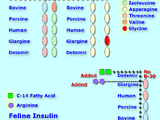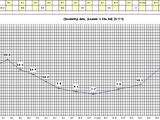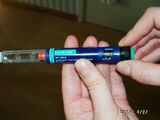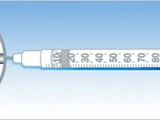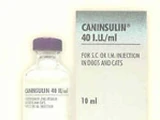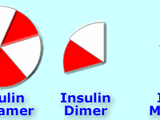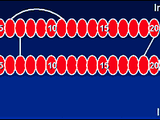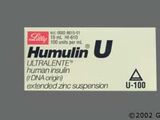The strength of an insulin is measured in International Units (IUs) of insulin per millilitre (ml). The two most common strengths are U40 (40 units insulin per ml) and U100 (100 units insulin per ml).
Insulins are categorized first by length of action, then by origin and by suspension. The five durations are:
- Rapid onset-fast-acting insulin
- Short-acting insulin
- Intermediate-acting insulin
- Mixed insulin
- Long-acting insulin
The usual times for onset, peak, and duration are found with the information for the insulin itself, but they also depend on the species, the suspension, and the individual. In particular, a given insulin that lasts, say, 20 hours in humans or dogs is more likely to last 10 hours in cats due to cats' faster metabolism. So the times found here are average for humans and dogs, but will last less time in cats.
Insulins differ by species. Most commonly available types are:
- r-DNA human insulin
- Genetically-engineered (GE) human insulin
- Genetically-modified (GM) human insulin
- porcine (pork) insulin
- bovine (cow) insulin
- human analog insulins
Porcine insulin is identical to canine. Bovine insulin is similar to feline, differing by only a single amino acid in position 18. (Mnemonic device: piG=doG, Cow~=Cat). Both differ in up to four amino acids (positions 8, 10, 18, 30) from natural human insulin.[1] Porcine (pig) and bovine (cow) insulins can be combined to produce a "blended" insulin (such as Iletin I (beef/pork), PZI Vet). Genetically-engineered artificial insulins with different amino acid composition such as Lantus, Levemir, Humalog, Novolog and Apidra, are known as analog insulins.
The suspension (liquid the insulin is suspended in) is the key to its activity over time. Typical suspensions are Isophane (NPH) Zinc (Lente, Ultralente) and Protamine Zinc (PZI). In general, all insulins with the same suspension will have a similar time activity profile and behave similarly. In non-analog insulins, it is the suspension that makes intermediate and long-acting types work longer than R/neutral. This is one reason why insulins should be diluted only with the correct approved diluent for that insulin.
More details on insulin types for animal use
More general insulin information Good illustrations and charts for seeing where bovine and porcine insulins differ from human insulin and how analog insulins Lantus (insulin glargine), Novolog (insulin aspart) and Humalog (insulin lispro) have been altered to produce their respective effects. Some absorption discussion re: humans, some of which is relevant to animals, as absorption is an important factor in how the insulin is used for all with diabetes. Time activity profiles for everything except Levemir and any PZI. Aspart/Lispro chart would be applicable for the new Aventis Apidra, as it is also a rapid-acting insulin designed for bolus in humans.
All items (146)
- Humalog
-
Humalog 75/25
-
Humalog Mix 25
-
Humalog Mix 50
-
Humulin
-
Category:Humulin
-
Humulin 50/50
-
Humulin 70/30
-
Humulin I
-
Humulin L
-
Humulin M2
-
Humulin M3
-
Humulin M5
-
Humulin N
-
Humulin R
-
Humulin S
-
Humulin U
-
Humulin Zn
-
Hypurin Bovine Isophane
-
Hypurin Bovine Lente
-
Hypurin Bovine Neutral
-
Hypurin Bovine Protamine Zinc
-
Hypurin Porcine 30/70 Mix
-
Hypurin Porcine Isophane
-
Hypurin Porcine Neutral
-
Hypurin Vet Neutral
-
Hypurin Vet Protamine Zinc
- Iletin
-
Iletin I Lente
-
Iletin I NPH
-
Iletin I R
-
Iletin II Lente
- Iletin II NPH
- Iletin II R
- Injecting insulin
-
Insulatard
- Insulin
-
Category:Insulin buffers
- Insulin pen
-
Category:Insulin preservatives
-
Insulin resistance
-
Category:Insulin suspensions
-
Insulin use tips
-
Category:Insuman
-
Insuman Basal
-
Insuman Comb 15
-
Insuman Comb 25
-
Insuman Comb 50
-
Insuman Rapid
-
Category:Insuvet
-
Insuvet Lente
-
Insuvet Neutral
-
Insuvet Protamine Zinc
-
Category:Intermediate-acting
-
Category:Intervet
-
Category:Intravenous use NO
-
Category:Intravenous use YES
